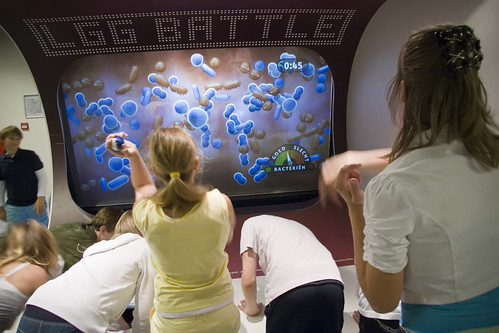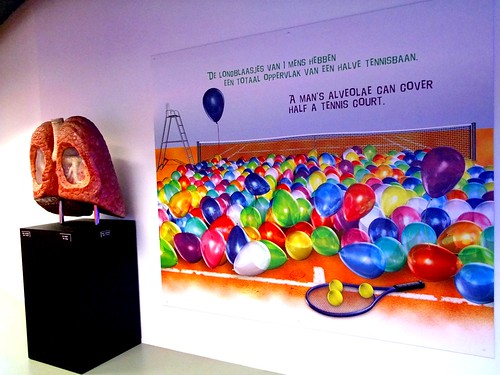| The introductory tourist video, which explains Corpus facts and figures at a glance. |
Corpus, devrived from the Latin word for body, is the name of an immersive museum located in the Netherlands, and much like a handful of the museum exhibits covered in Footsteps, it is a museum combining two different experiences, both of which the Wonders of Life would have looked up to. Being a unique exhibit of its kind, and not just recognised with critical acclaim in Europe (but likely the whole wiorld), here's a quote from its official website:
There is nowhere else where you will be able to take such a special look at how the human body functions. You will learn how the human body is made up, how it works and what you should do to keep it healthy. A healthy lifestyle, balanced diet and enough exercise form the philosophy of CORPUS!
 |
 |
| Part of a walk-through innerspace tour, as seen in the CBS photo gallery: http://www.cbsnews.com/2300-501843_162-3938831-3.html | |
- starting from the knee joint, which describes the muscular and skeletal systems, describing and demonstrating movement, and even the formation of blood cells in bone marrow
- along the blood vessels and circulatory system, including a show on the workings of the human heart (the Heart Theater)
- the inside of the mouth and the stomach, demonstrating the digestive process (kids will appreciate getting to jump on the rubbery bouncy tongue surface, as well as the awe of surrounded by the infamous borborygmous-gurgles and belches from down the tract)
- the beginning of life - conception - and life inside the womb, tracing on embryonic and foetal development of a new life (Womb theater)
- the nervous system, with an iconic biological-demonstrative show of the brain and its relationship with the body.
The interactive displays and exhibits, demonstrated in the above photos and videos, indicate its appeal towards young and old, such as the use of engaging graphics for visual fact files on the amazing aspects of our body, for instance. While the anatomical displays by current standards may not necessarily add to interactivity value, it does allow guests to literally take a sneak peek at their organs up close and personal, and even get to know some of their interesting facts and statistics.
With regards to design elements, especially with some source photos of the Medical Information centre of the museum, the striking navigational key tying parts of the area together is a large arterial model, the 'lifeline' of the exhibit, which also houses some smaller exhibit components. Bright colours and eyecatching displays, even when staying true to the anatomical and medical aspects of the exhibits regardless of location. The design layouts were up to date, they were streamlined and contemporary, and they definitely do their best to attract, interest and educate audiences.
With regards to design elements, especially with some source photos of the Medical Information centre of the museum, the striking navigational key tying parts of the area together is a large arterial model, the 'lifeline' of the exhibit, which also houses some smaller exhibit components. Bright colours and eyecatching displays, even when staying true to the anatomical and medical aspects of the exhibits regardless of location. The design layouts were up to date, they were streamlined and contemporary, and they definitely do their best to attract, interest and educate audiences.
| The "Making Of" video, showing the construction and extensive research put into the museum. (The language used is purely Dutch; just concentrate on the construction and designing part) |
A lot of intricate detail has been put into the models, which somehow would remind some of you readers of what would have been part of the Incredible Journey Within ride. Truly, with a lot of research done into the areas of the body to be explored by guests, you can clearly say that the people involved in the making of Corpus have succeeded in transferring guests into another world on the inside. (Even the Dutch royal family was impressed!)
With regards to the biomedical side of life and health, Corpus has managed to hit the nail on the head quite nicely, being the center-point museum now known around the Netherlands (if not Europe-wide), and as WOL4EVA notes in this article, this I cite as a source of inspiration, or even a similar-niche museum or exhibit following in a more realistic, logical but all the more amazing footstep pattern.
As always, here are some pages cited for your pleasure of following up at your own online leisure:
- Corpus Netherlands (n.d.) CORPUS 'Journey through the Human Body' - Home. [online] Available at: http://www.corpusexperience.nl/en/corpus-experience/ [Accessed: 21 May 2012].
- Corpus Netherlands (n.d.) CORPUS 'Journey through the Human Body' - Medical Advisory Board. [online] Available at: http://www.corpusexperience.nl/en/about-corpus/medical-advisory-board [Accessed: 24 May 2012].
- Holland.com. [online] Available at: http://www.holland.com/uk/tourism/article/corpus-leiden.htm [Accessed: 21 May 2012].
- Spot Cool Stuff (2011) Unusual Museums: The Corpus Museum In Netherlands | Spot Cool Stuff: Travel. [online] Available at: http://travel.spotcoolstuff.com/unusual-museum/amsterdam/corpus-human-body [Accessed: 21 May 2012].




No comments:
Post a Comment
Commenting is a very helpful method for the following reasons - to provide any information or thoughts on the subject, as well as critiquing or making suggestions. Please note that all comments are moderated, so please plan carefully. Also, if you enjoyed the article, feel free to share it with your friends!